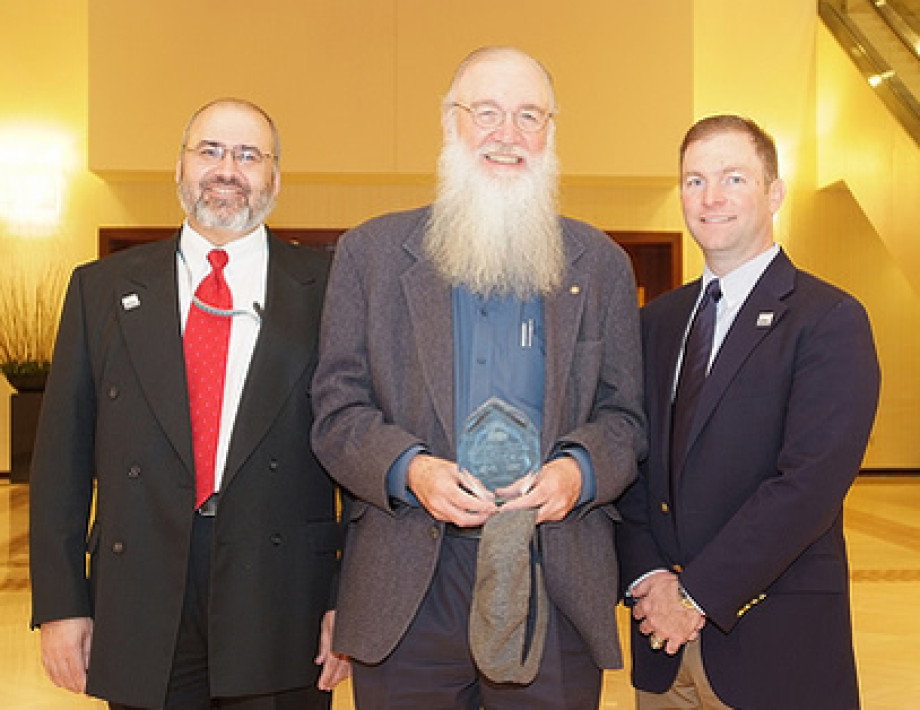Department of Energy's ESnet Wins 2009 Excellence.Gov Award for Effectively Leveraging Technology

The Award Goes to ESnet: (from left to right) Vince Dattorria, Bill Johnston and Steve Cotter, of ESnet show winning smiles at the Excellence.gov award luncheon in Washington D.C.
Contact: Jon Bashor | CSnews@lbl.gov
WASHINGTON, D.C. — The U.S. Department of Energy's Energy Sciences Network (ESnet), a high-speed network linking tens of thousands of researchers around the nation, was honored on April 14, 2009 with an Excellence.Gov award for its achievements in leveraging technology.
The Excellence.Gov awards are sponsored by the Industry Advisory Council's (IAC) Collaboration and Transformation Shared Interest Group and recognize the federal government's best information technology (IT) projects. This year's theme, "Transparency: Using IT to improve the interaction between Government and its Stakeholders," focuses on how government organizations use IT transparently to improve the public's information gathering abilities, or an agency's ability to deliver information to the public or a particular constituency. A panel of 25 judges; federal government and industry executives —reviewed the nominations and selected ESnet as the winner in the area of “Excellence in Leveraging Technology,” one of five award categories. The winners were recognized at a ceremony in Washington, D.C.
ESnet was honored for the innovative uses of switching and routing technologies in its Science Data Network, a recently completed network infrastructure running over a dedicated optical infrastructure shared with Internet2 to provide highly reliable, high-bandwidth connectivity to support and advance the United States’ scientific competitiveness and capabilities by linking scientists at national laboratories and universities across the country.
“This is both exciting news and well-deserved recognition of ESnet's excellent efforts to meet the increasingly data-intensive demands of the DOE research community,” said Michael Strayer of DOE's Office of Advanced Scientific Computing Research, which oversees ESnet. “Since it was established in 1986, ESnet has consistently anticipated the future needs of our scientists and deployed the infrastructure to accommodate those anticipated requirements as they became reality.”
ESnet is funded primarily by the DOE Office of Science and is managed by Lawrence Berkeley National Laboratory (Berkeley Lab) in California.
“Wow! This is great to have the efforts of the ESnet staff recognized by our peers in the IT community,” said Steve Cotter, head of ESnet at Berkeley Lab. “In today's world, we often take reliable networking for granted, but this award recognizes that a tremendous amount of effort goes into making sure the network is up and running 24/7.”
Because the DOE Office of Science is one of the largest supporters of basic research in the physical sciences in the U.S., supporting researchers at 40 DOE sites as well as universities across the country, reliable network connectivity is critical to support collaborations and allow scientists to share massive datasets from experiments and supercomputing simulations.
The ESnet4 network architecture consists of two national core networks with a richly interconnected topology built from multiple 10 gigabit per second (Gb/s) circuits on each link between hubs. One of the two core networks, built from single 10 Gb/s circuits between the hubs, is dedicated to the Internet IP traffic that supports Lab operations, general science communication and collaboration, and science with relatively small data movement requirements. The second core network — the Science Data Network (SDN) — consists of at least one 10Gb/s link between the hubs, with the number of such links increasing by approximately one every year for the next two to four years, resulting in a 40–60 Gb/s national core network by 2011. This growth in SDN network capacity is intended to match the projected growth in the use of the network by large-scale science projects such as the Large Hadron Collider, supercomputing centers, and new facilities such as DOE’s Spallation Neutron Source, etc.
ESnet4 was designed and deployed to enable scientists at multiple locations to transfer, access and analyze massive datasets. One of the main drivers is the looming tidal wave of scientific data to become available once the Large Hadron Collider (LHC) at CERN in Switzerland goes into production in 2009.
To ensure that the requirements of the scientific community are fully understood, ESnet regularly holds meetings with “customers” (the scientists who rely on the network) and stakeholders from funding organizations. Reports of the meeting results are published on the web for free distribution.
Additionally, ESnet is a member of the international networking community and has strong working relationships with network organizations in North America (Internet2, National Lambda Rail, CANARIE), Europe (GEANT, DANTE) and Asia (SiNet, TANet2, AARnet). ESnet staff attend collaboration meetings, discuss projects and results at international conferences and, as is the nature of their work, are in constant contact with peers around the world, finding solutions, solving problems and addressing future needs.

About the DOE Office of Science
With a Fiscal Year 2009 budget of $4.8 billion, the DOE Office of Science is the largest funder of basic research in the physical sciences in the United States. The steward of ten National Laboratories, the Office of Science funds research at National Laboratories and over 300 universities nationwide through programs in advanced scientific computing research, basic energy sciences, biological and environmental research, fusion energy sciences, high energy physics, and nuclear physics.

